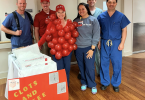If you visited the Georgia Cancer Center at Augusta University, you’d find sketches straight out of a fantasy, complete with hearty heroes and heroines, formidable fiends and legendary landscapes. If you looked a little closer, you’d notice the photos and read the descriptions of what each sketch represents, giving you a glimpse into something very real.
Behind the drawings, photos and descriptions is the spirit of a brave cancer survivor, Roel Wielinga of Thomson, Georgia — the author and illustrator. The Living Walls at the Georgia Cancer Center tells his story, each sketch so vividly symbolizing a particular episode in Roel’s treatment. He attributes the great detail of his artwork to the different person that cancer has made him.
“When something like cancer gets thrown in your face, you end up with a more open mind,” Roel said. “All of the things that you used to take for granted you now notice.”
The formidable fiend invades
In June 2009, Roel was at the grocery store when he felt dizzy and was unable to stand up straight or hold his balance. In the coming days, he started feeling progressively weaker and struggled with staying focused. Walks with his beloved wife of 20 years, Marian, got shorter. Suddenly, he experienced more acute symptoms like bleeding of the gums, bruises and muscle spasms. When the muscle spasms in his back became severe, he decided it was
In August 2009, right around the time of the Wielingas’ wedding anniversary, Roel was diagnosed with acute myeloid leukemia, a rapidly progressing cancer of the blood and bone marrow. Within three days, he was admitted to the hospital and was deemed in remission in October of that year.
Using talent as treatment
Roel felt overcome by the urge to draw, which wasn’t anything uncommon for him. However, his sketchbook was at home, and he was unable to leave the hospital. So Marian, a retired art teacher, went home to get it. Over time, his sketches told a cohesive story.
“He started drawing [during his treatment], because that’s what he does,” Marian said. “He used it as a release for what he was going through and realized that it was working for him and could work for others.”
Dr. Amy Allison, director of the psycho-social oncology service at the Georgia Cancer Center said that the process of creating can be therapeutic for many people. “Expressive therapies, such as art and music therapy, can serve as an outlet for expressing your feelings about illness, treatment and life itself,” Allison said. “In addition, the process of seeing, hearing and exploring the work you create through art and music therapy can distract you from health issues.”
Roel agrees.
“The most powerful thing that we have is our minds,” Roel said, “because the mind controls how the body functions. So I visually represented what was going on in my mind through artwork.”
Interested in knowing more?
Learn more about expressive therapies and other supportive care options at the Georgia Cancer Center. To learn about our cancer services and providers, call us at 706-721-6744 or visit augusta.edu/cancer.

